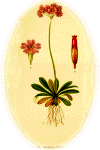


|
|
In search of spring flowers A quest for the stinking hellebore |
|
|
One February morning some years ago my brother and I set out from Cromer to look for stinking hellebore Helleborus foetidus. In February the nose is too cold to smell much in the field, and it wasn't the stinking aspect that interested us. It was those strange green flowers with their burgundy-dipped edges, and the dark green shining leaves. There's something seductive about them, and something sinister - they seem untouched by insects, spared the attention and the corrosions of leaf miners, biters, chewers and scrapers. Spring doesn't start in February, but the year is awakening. This trip felt like a botanical reawakening. You know what I mean: you get out your boots and your favourite field guide and awake from the slide-show slumber of winter and you shake out the cobwebs and go botanising again. The hellebore likes woods on chalk. There isn't that much chalk at the surface in Norfolk, so where to look? I like to find plants by my own devices, but I also like to leaf through Floras, choosing plants and places, and then going looking for them. The Flora we had was Petch and Swann's Flora of Norfolk, a companion on many rewarding plant hunts. Petch and Swann had the hellebore at the Bath Hills, Ditchingham, South Norfolk! A long way from home. But it was a clear day, with a bright and cold February sun shining from a faultless sky ... I like plants and I like to find them. And I also like to ask them why they are there. Why, for example, is that discreet little white crucifer flowering on that grassy bank in March? Perhaps it gets its flowering completed and seed set before the grass closes over it? Perhaps. But equally importantly, and we all ask this of the little crucifer on a bank at the start of the year: what the heck are you? Let's face it, we all go a bit rusty during the close season. Most of us have to learn those little plants, and those awkward grasses, again each year. No such problem with the hellebore, of course: it's unmistakable. This didn't help us at all as we ambled through the woods on the Bath Hills. We found gladdon, tilting its head back lasciviously to show off its berries, an intense primary red against the quiet and sombre browns and greys of the winter leaves. The winter light, brittle and sharp, sought out the berries. This is what I like about woods in spring: no leaves. The light comes through to the floor. And while it does so, the classic spring flowers rush to use it: wood sorrel, wood anemone, ramsons, bluebell: all of them surging to flower and fruit before the trees awaken too and the soft green night closes above. |
In Norfolk we have a few woods that are home in that spring light to one of the most beautiful of our spring flowers - the wild daffodil, the Lent lily. Lit by sun, seven inches tall, pale yellow and rich golden yellow, fragile and bold, it swarms on the woodland floors, a marvellous flower. It is another tactician of the wood: growing from its underground stores up to a bare, competition-free floor, flowering and photosynthesising while the light lasts, then lying low for the rest of the year. Economical and elegant, it is the perfect daffodil. Forgive me, you modern gardeners, but those brassy, brash, cheap show-offs you favour for your borders are much too loud, far too common. One of my best-ever botanical moments was on a spring day in a daffodil wood in north Norfolk. From a high point I looked down on a sea of daffodils, all nodding and shaking in a faint breeze just warmed by April sun. Then among them a darker yellow caught my eye and I knew I had found what I was hunting. An engraving on the front of a rare local flora. An empty dot in the Atlas of the British Flora. Tulipa sylvestris, the wood tulip, the wild tulip. A botanical treasure in every way, slender and snakelike, scented. And, best of all, I'd refound it. No such luck with the hellebore. We'd quartered the woods and found nothing. The day was closing. A little snow blew in from a heavier sky. A flake settled on the green flower of dog's mercury, and stayed there. A sparrowhawk shot short-winged through the darkening space between the bare twigs to the dusk. And there was the hellebore. Plant after plant along a bank by the lane. I'd swear we'd walked along there an hour or so before. Like all the best plants it had surprised us, it was suddenly there, like magic. Why does it grow just here, at the edge of the wood, in the dappled light that remains? For the same reason as the other spring-lovers, I suppose, helping itself to the short-lived spring sun beneath the trees, and welcoming the first flies of the year into those strange pale green caves. I wonder if there's another reason too. The colony can be followed back along the lane to a little cottage. Could it have escaped from the garden? Was it there for decoration, or did it have a herbal use? If so, it must have made strong magic. The hellebore: no matter why it was there, we'd found it, or it had found us. Now all that mattered was to hurry home through the dark, to thaw our frozen hands and toes, and to talk about the next plant hunt, which would surely come soon. |
| Reproduced
from
PLANTLIFE with permission |
Tony
Hare
Dr Tony Hare is a Plantlife Vice President. He was Plantlife's first Chairman, and one of the six founders. |